| Please access the following URL if you want to secure using SSL. All pages in the site will be secure pages. |
| https://secure02.blue.shared-server.net/www.fish-food.co.jp/message english 6.2020.html |
Welcome to FISH FOOD TIMES
Jun. 2020 issue No.198

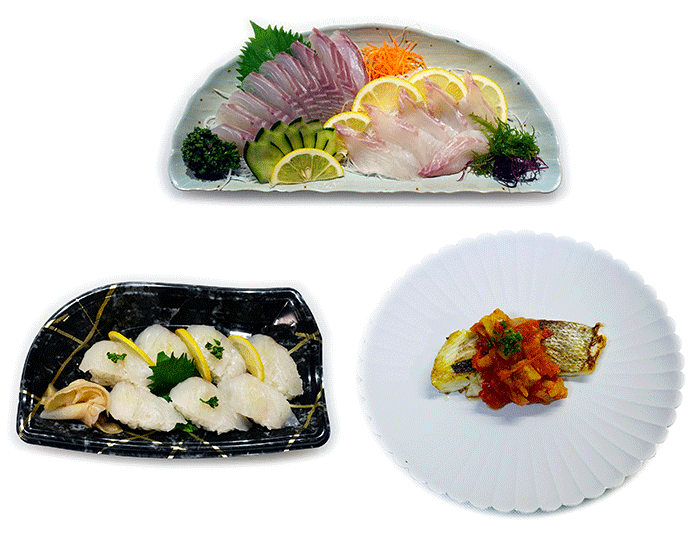
Commercialization of Japanese seabass
Major in the world of fish
Will it be a hot summer this year,,,? This year, I think that I have to wear a mask to get out of the house even in the hot summer, which makes me very frustrated. In particular, I think it's probably not the only author who can't stand the smell of saliva on the back of the mask. I hope that the day will come soon without wearing a mask.
Since the hot season has arrived, I would like to make a theme of "arai of Japanese seabass" chilled with ice, but I would like to ask, but in FISH FOOD TIMES, No.17 May 2005 issue, "japanese seabass ice arai" was taken up, so I will stop the second decoction. Just 15 years before FISH FOOD TIMES started, when I picked up Japanese seabass, it was just a product introduction level, and its contents were too poor. For this reason, the author has been eager to write down a major fish called Japanese seabass with a solid content.
Although the fish called Japanese seabass is described as a major fish, it can be said to be a major fish, and the Perciformes order has a family of 20suborde160family1,539genus10,033 species, which is the largest force not only in fish but also in vertebrates. Of these, more than 2,000 species belong to the suborders Percoidei, Labroidei, and Gobioidei, and these 3 suborders alone account for more than 75% of the perciformes. Most of the Perciformes are saltwater fish, but there are 2,000 species that live only in freshwater, and 2,300 species that temporarily live in freshwater for growth and migration.
This time, the Japanese seabass featured in this article spawns and overwinters in waters such as estuaries in winter, and performs relatively regular migrations in the inner bay and rivers from spring to autumn. Since it lays eggs in the winter, it seems that the Japanese seabass that migrated to the inner bay for egg laying may be in season, but at this time the body is thin and not so delicious due to nutrient gathering in the gonads, It is said that the summer season from June to August, during the process of storing nutrients, is the thickest and delicious.
The following image is Lateolabrax japonicus of Percifoumes order Percoidei suborder Lateolabracidie family Lateolabrax genus.

Very similar to this Japanese seabass is the blackfin seabass below.

This black fin seabass was picked up in the October 2018 issue of FISH FOOD TIMES No.178, so it's still early days, and I think some of you still remember it. If you haven't read it, please read this as well.
Other than this, there seems to be a large-sized species native to China called Spotted seabass and a hybrid of Suzuki and Spotted seabass called Ariake seabass, but I have not seen it. Furthermore, in Europe, there is a related species called European sea bass (Percifoumes order Percoidei suborder Morocene family Dicentralux). This is a different kind from the large alien largemouth bass (Percifoumes order Percoidei suborder Sunfish family largemouth bass genus) which is generally called black bass.
Also, be careful about the Japanese name Shiro Suzuki. This is the name of the Nile perch native to Africa (Percifoumes order Percoidei suborder Latidae family Lates genus) in Japan, and this frozen Nile perch is used as a material for white fries in restaurants and food services. However, it is forbidden to use the name of Shiro Suzuki for Nile perch at the fish counter, so it must be accurately labeled as Nile perch native to Africa.
Commercialization of Japanese seabass
The disassembling cooking process of Japanese seabass is almost the same as that of blackfin seabass, so if you want to know the cooking process, please see blackfin seabass. This month's issue will be omitted.
I tried to commercialize sashimi as follows.
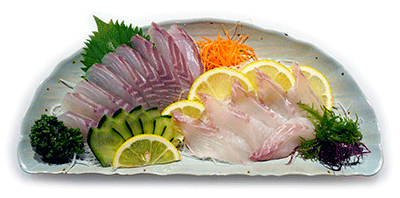
There are 9 pieces of hiratsukuri sashimi on the left side of the container and 6 pieces of usutsukuri sashimi on the right side of the container, totaling 15 pieces.
When asked if Japanese seabass sashimi is a product that sells well, unfortunately I can't say yes. The reason is that the pattern under the skin is not as bright as red sea bream, but it has a slightly dull red hue, so even if the freshness is good, it may be mistaken for a little old sashimi, and as a white flesh sashimi It can never be said that the movement is good. For this reason, in order to appeal the freshness with white flesh, we tried to commercialize not only hiratsukuri sashimi but also usutsukuri sashimi.
In this way, usutsukuri sashimi is more prominent in freshness than hiratsukuri sashimi, in which the dull color pattern under the skin is more noticeable. Also, sushi dane of nigiri sushi is one of the same usutsukuri sashimi techniques, so the dull shade of the subcutaneous pattern is not noticeable as shown in the image below.
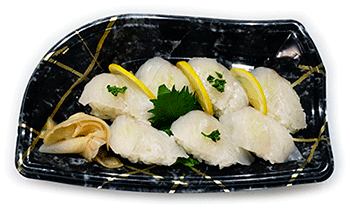
Japanese seabass is one of the fish that has a great praise or censure depending on the region. Originally it is a very delicious fish, but in some areas it is treated like a lower fish. One of the causes that can be seen only in low-value fish is that during the high growth period, when Japanese seabass lived in estuaries and brackish waters, water that had been polluted by factory effluents and domestic effluents was drained in the past. This is because the value of Japanese seabass, which had the odor of oil and mud, was circulated under the influence of the polluted water of the river during the era, and the value of the seabass had fallen. Japanese seabass, like mullet, are fish that live in estuaries and brackish waters, and inevitably the value and trade rate are affected by such environmental factors.
As for Japanese seabass, which is endemic to Japan, there is a description in the Kojiki that Ohkuninushinomikoto ate Japanese seabass at the feast. It is a fish that has been familiar since ancient times, as many bones are thrown away after eating from the shell mound, and its habit-free with white fresh is a fish that is often used in French dishes as well as Japanese dishes.
Japanese seabass western dishes
The Japanese seabass was made into three pieces disassembling, and the half body was commercialized as sashimi and sushi, and the latter half body was commercialized by cutting 3 pieces for slice.
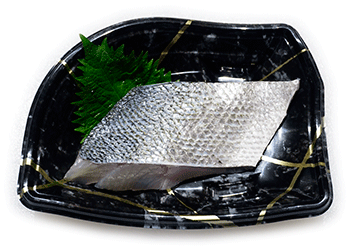
Let me introduce a simple Western-style dish using Japanese seabass fillets.
| Ratatouille-style saute cooking process | |
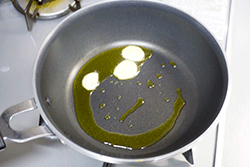 |
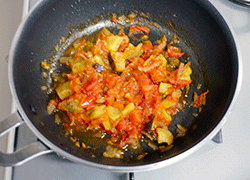 |
| 1,Add butter to the frying pan. | 5,Add a little consomme soup and season with salt and pepper. |
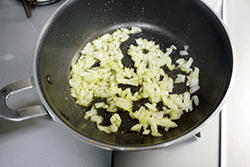 |
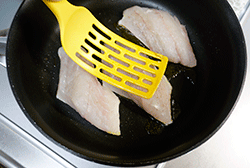 |
| 2,Add the chopped onion. | 6,Put the fillet in another frying pan with melted butter, skin side down. |
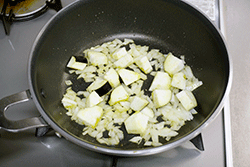 |
 |
| 3,Add the cut eggplant. | 7,When the skin is cooked, turn it over. |
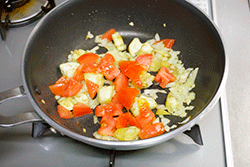 |
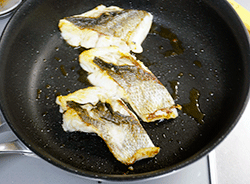 |
| 4,Add the cut tomatoes into small pieces. | 8,Bake until the whole is cooked. |
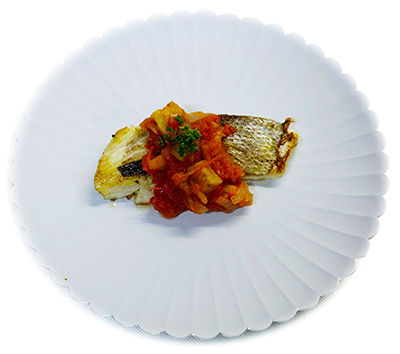 |
|
| Ratatouille-style saute completed | |
Fish nutrition and selenium
Although Japan's declaration of emergency has finally been lifted, it cannot be said that the new coronavirus has ended yet, and daily economic activities will only begin to fumble in June. In such a situation, the most important concern in the world today is health. At the moment, it seems that one of the things that attracts a great deal of attention is how to provide resistance against infection with the new coronavirus.
Japanese seabass is a typical "low-fat high-protein white fresh", which is a nutritious fish that can be used as a nutritional food for the sick. Last month's FISH FOOD TIMES No.197 May issue mentioned the following about selenium, one of the bonito nutrients.
| ... Bonito is not only rich in protein, but in addition to the well-known DHA and EPA, it is rich in vitamin D, B6, B12, and niacin as shown in the table below. Recently, it has been noted that it contains a large amount of selenium, which activates the longevity hormone DHAE from the adrenal gland. ... |
The paper that the selenium attenuates the new coronavirus was published in the Journal of the American Society of Clinical Nutrition on April 28th.
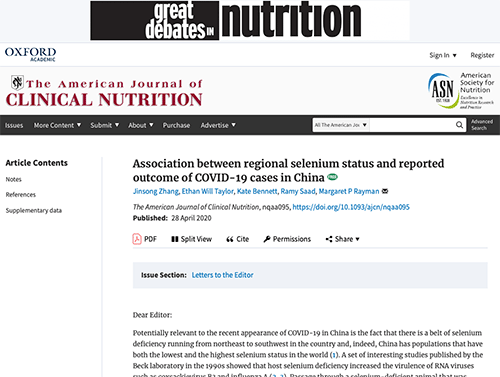
The fact that bonito is abundant in bonito is described as follows in the Japanese Food Standard Ingredient Table 2015 edition (7th edition).
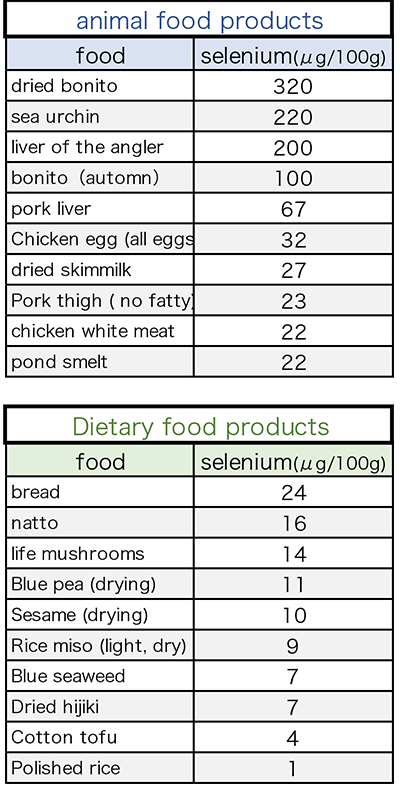
What exactly is this substance called selenium, let's briefly describe its features below.
Selenium is a metal that means the element symbol Se, atomic number 34, and the Greek word selene, and was once known as a highly toxic element, but recently it has been recognized that it is an essential trace element for humans. It was It forms part of enzymes and proteins in the body and plays an important role in antioxidant reactions. However, due to the small difference between the required amount and the poisoning amount, caution is required in its intake.
Selenium in food exists by being bound to protein and is absorbed into the body at the same time as this protein. About 250 μg of selenium is present in the human body per kg of body weight, and this value is constantly maintained by excreting the ingested selenium in the urine.
It is said that selenium is rarely deficient in normal diets in Japan, but it has been suggested that lack of selenium increases the risk of dry skin, myocardial damage, and carcinogenesis. On the other hand, since selenium is highly toxic, chronic overdose may cause gastrointestinal disorders, neuropathy and renal failure.
Then how much selenium should I take? The following table shows the food intake standards for each age group (Japanese food intake standards for 2020). By the way, the average intake of Japanese is about 100 μg / day.
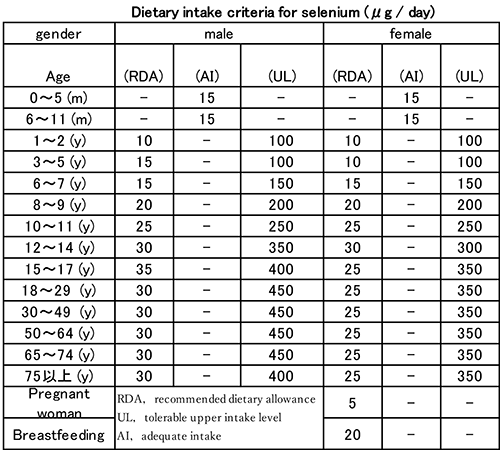
It is said that selenium will not be deficient if you have an ordinary diet that is not biased, but this is because "dried bonito is used to eat broth" is the basis of Japanese diet. It can be seen that what they are doing contributes to the fact that the Japanese are not lacking in selenium.
It seems that the effectiveness of selenium in attenuating the new coronavirus has not been fully verified at this time. If drinking soup or miso soup made from dried bonito would lead to resistance to the new coronavirus, it would be a great pleasure for a Japanese person.
As of now, the number of people infected with the new coronavirus in Japan is overwhelmingly smaller than the number of people worldwide. If the Japanese diet based on fish has a strong resistance to the new coronavirus, then in Japan where "Fish away phenomenon" has occurred, the fact that a pandemic has made the merit of fish diet a new one, it may be an opportunity to make people aware.
Japanese seabass nutrition
This month's issue may have the impression that the Japanese seabass theme has replaced the selenium story, but not. The author used the topic of the substance selenium to convey the wonderful nutritional balance of the Japanese seabass fish, which has been eaten since ancient times in Japan.
Japanese seabass was mentioned above as a typical "low fat, high protein white flesh" that is a nutritious fish that can also be used as a nutritional food for the sick. The amount of lipid is as low as 4.2g per 100g, but it contains DHA and EPA, which are omega-3s, well. A major feature is that 620 mg per 100 g of monounsaturated fatty acid oleic acid that prevents high blood pressure and lowers LDL (bad cholesterol) is contained.
What is this monounsaturated fatty acid oleic acid, and let's mention this as one of knowledge of nutrition of fish like selenium.
Oleic acid is one of the monounsaturated fatty acids, and especially it is contained in a large amount such as olive oil, and it is positioned as shown in the figure below.
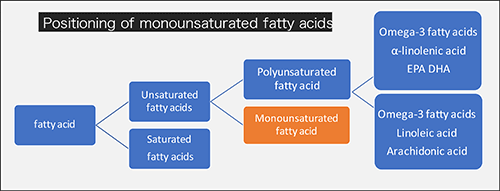
Unsaturated fatty acids have the effect of reducing cholesterol, but have the drawback of being easily oxidized to lipid peroxides. On the other hand, oleic acid has a property that it is difficult to form lipid peroxides and can exhibit stability against oxidation. It also works to reduce blood cholesterol and prevent lifestyle-related diseases. People living along the Mediterranean coast of olive origin have a very low incidence of myocardial infarction, and there is a deep link between the low incidence of heart disease and oleic acid in olive oil.
Oleic acid, which works like this, is noticeably abundant in Japanese seabass. On the other hand, the polyunsaturated fatty acids of Japanese seabass are present in lesser amounts than red fish such as tuna and bonito. On the contrary, this is the reason why Japanese seabass is said to be the representative of "low fat and high protein white flesh".
At this time, let's deepen our knowledge a little more about unsaturated fatty acids, which are popular for their nutritional benefits.
The figure below briefly shows the types and structures of fatty acids and their characteristics.
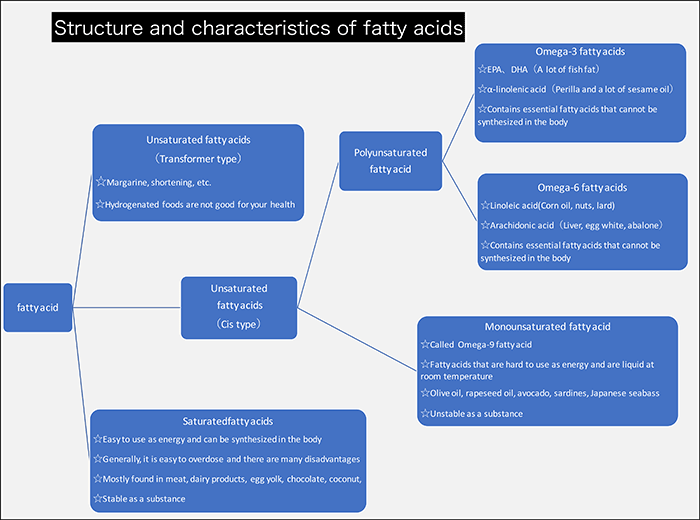
It is known that lipids are one of the three major nutrients, and have the same amount of energy as carbohydrates and proteins, and therefore the risk of lifestyle-related diseases increases if too much is consumed. The ratio of energy obtained from lipids is called the "lipid energy ratio", and it is said that the higher the ratio, the more likely it is to lead to obesity and metabolic syndrome.
According to a 2018 survey by the Ministry of Health, Labor and Welfare, about 35% of Japanese adult males and about 43% of adult females exceeded the fatty acid target value (20% to less than 30% of total energy intake).
Japanese seabass, which is a "low fat, high protein white flesh” is effective in preventing excessive intake of lipids, and is rich in protein for energy, so it is one of the foods that is ideal.
The market price of fish is still at a low level in general, and I would like you to appeal the nutritional benefits of Japanese seabass and sell it at a price that is easy for customers to buy.
| Please access the following URL if you want to secure using SSL. All pages in the site will be secure pages. |
| https://secure02.blue.shared-server.net/www.fish-food.co.jp/message english 6.2020.html |
An opinion and the communication are to iinfo@fish food times
Date of updating 1 Jun. 2020
